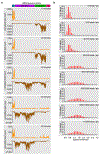Cas13-induced cellular dormancy prevents the rise of CRISPR-resistant bacteriophage
- PMID: 31142834
- PMCID: PMC6570424
- DOI: 10.1038/s41586-019-1257-5
Cas13-induced cellular dormancy prevents the rise of CRISPR-resistant bacteriophage
Abstract
Clustered, regularly interspaced, short palindromic repeat (CRISPR) loci in prokaryotes are composed of 30-40-base-pair repeats separated by equally short sequences of plasmid and bacteriophage origin known as spacers1-3. These loci are transcribed and processed into short CRISPR RNAs (crRNAs) that are used as guides by CRISPR-associated (Cas) nucleases to recognize and destroy complementary sequences (known as protospacers) in foreign nucleic acids4,5. In contrast to most Cas nucleases, which destroy invader DNA4-7, the type VI effector nuclease Cas13 uses RNA guides to locate complementary transcripts and catalyse both sequence-specific cis- and non-specific trans-RNA cleavage8. Although it has been hypothesized that Cas13 naturally defends against RNA phages8, type VI spacer sequences have exclusively been found to match the genomes of double-stranded DNA phages9,10, suggesting that Cas13 can provide immunity against these invaders. However, whether and how Cas13 uses its cis- and/or trans-RNA cleavage activities to defend against double-stranded DNA phages is not understood. Here we show that trans-cleavage of transcripts halts the growth of the host cell and is sufficient to abort the infectious cycle. This depletes the phage population and provides herd immunity to uninfected bacteria. Phages that harbour target mutations, which easily evade DNA-targeting CRISPR systems11-13, are also neutralized when Cas13 is activated by wild-type phages. Thus, by acting on the host rather than directly targeting the virus, type VI CRISPR systems not only provide robust defence against DNA phages but also prevent outbreaks of CRISPR-resistant phage.
Conflict of interest statement
Figures










Comment in
-
Bacterial dormancy curbs phage epidemics.Nature. 2019 Jun;570(7760):173-174. doi: 10.1038/d41586-019-01595-8. Nature. 2019. PMID: 31182829 No abstract available.
-
Playing dead during phage infection.Nat Rev Microbiol. 2019 Aug;17(8):461. doi: 10.1038/s41579-019-0226-1. Nat Rev Microbiol. 2019. PMID: 31197251 No abstract available.
-
Cas13 Helps Bacteria Play Dead when the Enemy Strikes.Cell Host Microbe. 2019 Jul 10;26(1):1-2. doi: 10.1016/j.chom.2019.06.012. Cell Host Microbe. 2019. PMID: 31295418 Free PMC article.
References
-
- Mojica FJ, Diez-Villasenor C, Garcia-Martinez J & Soria E Intervening sequences of regularly spaced prokaryotic repeats derive from foreign genetic elements. J. Mol. Evol. 60, 174–182, (2005). - PubMed
-
- Bolotin A, Quinquis B, Sorokin A & Ehrlich SD Clustered regularly interspaced short palindrome repeats (CRISPRs) have spacers of extrachromosomal origin. Microbiology 151, 2551–2561, (2005). - PubMed
-
- Pourcel C, Salvignol G & Vergnaud G CRISPR elements in Yersinia pestis acquire new repeats by preferential uptake of bacteriophage DNA, and provide additional tools for evolutionary studies. Microbiology 151, 653–663, (2005). - PubMed
-
- Barrangou R et al. CRISPR provides acquired resistance against viruses in prokaryotes. Science 315, 1709–1712, (2007). - PubMed
Online references
-
- Rocourt J, Schrettenbrunner A, Hof H & Espaze EP [New species of the genus Listeria: Listeria seeligeri]. Pathol Biol (Paris) 35, 1075–1080, (1987). - PubMed
-
- Loessner MJ, Inman RB, Lauer P & Calendar R Complete nucleotide sequence, molecular analysis and genome structure of bacteriophage A118 of Listeria monocytogenes: implications for phage evolution. Mol. Microbiol. 35, 324–340, (2000). - PubMed
Publication types
MeSH terms
Substances
Grants and funding
LinkOut - more resources
Full Text Sources
Molecular Biology Databases

